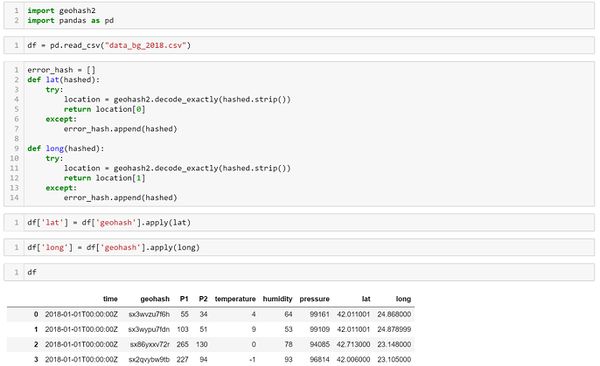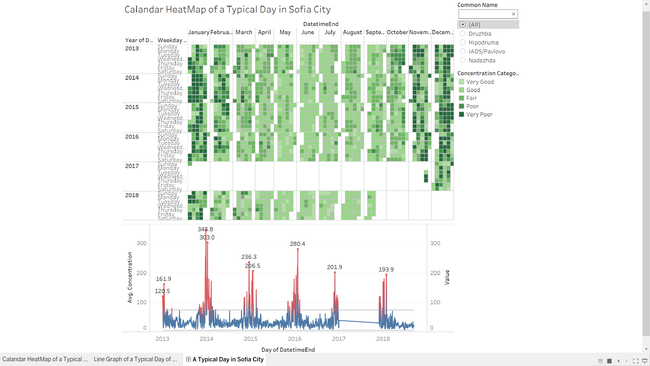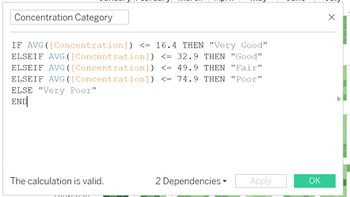Difference between revisions of "IS428 AY2018-19T1 Low Yun Vera"
| Line 49: | Line 49: | ||
A huge anomaly can be found in the dataset and also seen in the dashboard above. In the calendar heatmap in the year 2017 there is a large blank space. Also, in the line chart there is a stagnant line in the year 2017. This indicates that there is a large amount of missing values in the year 2017. This might affect my analysis of potential problems to the environment as 2017's data is missing, I am unable to tell if there were actually large concentration in the year of 2017. I am also unable to tell if this is a recurring problem of pollution in sofia city. | A huge anomaly can be found in the dataset and also seen in the dashboard above. In the calendar heatmap in the year 2017 there is a large blank space. Also, in the line chart there is a stagnant line in the year 2017. This indicates that there is a large amount of missing values in the year 2017. This might affect my analysis of potential problems to the environment as 2017's data is missing, I am unable to tell if there were actually large concentration in the year of 2017. I am also unable to tell if this is a recurring problem of pollution in sofia city. | ||
| − | [[File:Task1 cal plot 1 Vera.JPG| | + | [[File:Task1 cal plot 1 Vera.JPG|600px|center]] |
| − | [[File:Task1 cal plot 2 Vera.JPG| | + | [[File:Task1 cal plot 2 Vera.JPG|600px|center]] |
Also seen in the in the 4 dashaboards above, Nadezha has the lowest peak concentration as compared to the the other 3 stations. | Also seen in the in the 4 dashaboards above, Nadezha has the lowest peak concentration as compared to the the other 3 stations. | ||
Revision as of 07:58, 11 November 2018
Contents
Problem & Motivation
Air pollution is an important risk factor for health in Europe and worldwide. A recent review of the global burden of disease showed that it is one of the top ten risk factors for health globally. Worldwide an estimated 7 million people died prematurely because of pollution; in the European Union (EU) 400,000 people suffer a premature death. The Organisation for Economic Cooperation and Development (OECD) predicts that in 2050 outdoor air pollution will be the top cause of environmentally related deaths worldwide. In addition, air pollution has also been classified as the leading environmental cause of cancer.
Air quality in Bulgaria is a big concern: measurements show that citizens all over the country breathe in air that is considered harmful to health. For example, concentrations of PM2.5 and PM10 are much higher than what the EU and the World Health Organization (WHO) have set to protect health.
Bulgaria had the highest PM2.5 concentrations of all EU-28 member states in urban areas over a three-year average. For PM10, Bulgaria is also leading on the top polluted countries with 77 μg/m3on the daily mean concentration (EU limit value is 50 μg/m3).
According to the WHO, 60 percent of the urban population in Bulgaria is exposed to dangerous (unhealthy) levels of particulate matter (PM10).
Dataset Analysis & Transformation Process
There are 4 files provided to us. The AirTube, EEA Data, Meteo data and Topo-Data. This section of the wikipedia page will be explaining the data processing and exploratory data analysis of the files provided.
Air Tube
Issue : In this data set the geographical location given is in a geohash format.
Solution : In order to retrieve the latitude and longitude of the location, the use of a python geohash2 library is needed to decode the geohash.
data_bg_2017
There is a geohash "m-2105171”, due to the ‘-‘ in the hash the geohash2 library is unable to decode the geohash hence I have used an online geohash converter to decode the ‘m-2105171’. However, after converting the particular geohash to it's latitude and longtitude and plotting into Tableau it is found out that the particular geohash 'm-210517' is an outlier as shown in the image below highlighted by the red box. Hence, there is a need to remove the particular point.
data_bg_2018
There are 4 missing geohashes found in data_bg_2018.
EEA Data
After Exploring the data with Tableau, it is found out that there are missing values in 2017 from 1st Jan 2017 to 28th November 2017.
For station 9484 there is only data from 2013 - 2015, the year 2016-2018 is missing for that station and hence will be removing it from the analysis. Station 60881 only has data for the year 2018 and also will be omitted.
Issue: In the EEA file, the data for each bg_x_xxxx_year is separated into many different csv files. Solution: Using the Tableau Union function, I am able to merge the different datasets into one data. There is also a need to innerjoin the metadata on AirQualityEoiCode. This is so that i am able to link the bg_data to the 6 different stations.
Task 1: Spatio-temporal Analysis of Official Air Quality
The above dashboard shows the typical day of Sofia city by weekday from Sunday - Saturday. The concentration is separated into 5 different categories using a calculated field in tableau.
It can be seen that a typical day have around good to fair concentration categories. However, in the month of October to January the concentration of air pollution is very poor. Concentration is especially bad from December to January. The highest concentration would be on 25th December 2013. This might be due to a strict Bulgarian tradition that demand a fire to be built on a hearth with enough wood to burn all night into Christmas day resulting in especially high concentration during the festive seasons.
Throughout the years the concentration have also been decreasing as seen by the line chart. This might also be due to the fact that the Christmas tradition now has been replaced with lighted candles which produces less pollutants reference found in reference. From the line chart though there are some peaks of high concentration, overall concentration seems to be good.
A huge anomaly can be found in the dataset and also seen in the dashboard above. In the calendar heatmap in the year 2017 there is a large blank space. Also, in the line chart there is a stagnant line in the year 2017. This indicates that there is a large amount of missing values in the year 2017. This might affect my analysis of potential problems to the environment as 2017's data is missing, I am unable to tell if there were actually large concentration in the year of 2017. I am also unable to tell if this is a recurring problem of pollution in sofia city.
Also seen in the in the 4 dashaboards above, Nadezha has the lowest peak concentration as compared to the the other 3 stations.
Task 2
Task 3
References
https://github.com/DBarthe/geohash








